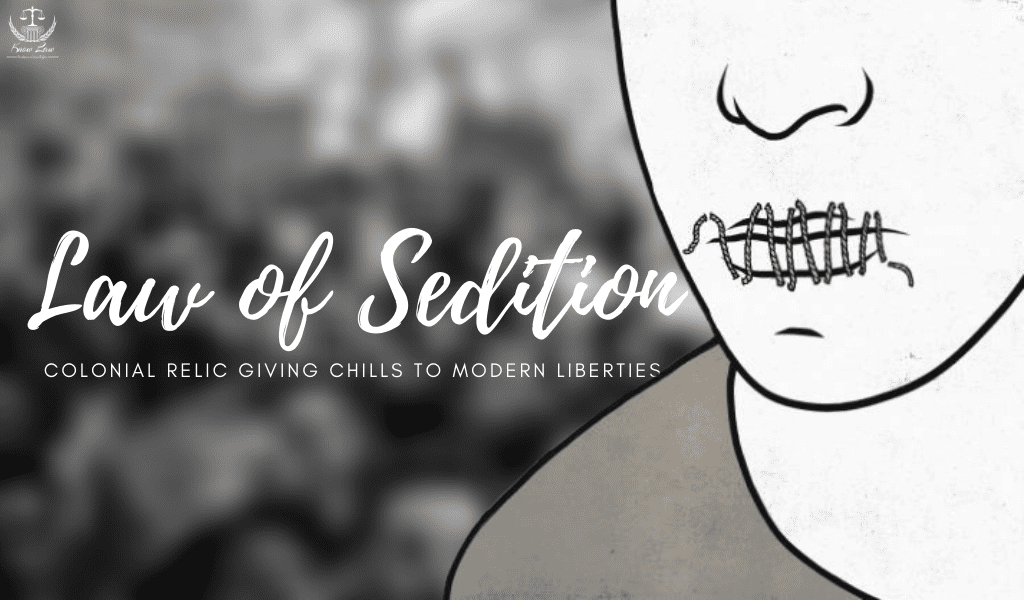
The right to hold opinions and freedom of expression is the mainspring of every free and democratic society. The Constitution of India guarantees this right to its citizenry, with certain restrictions, for the exchange and development of opinions. However, it has been reiterated time and again that a restriction on expression must further a legitimate aim and should be proportionate to the intended objective. In contemporary times, this is the most celebrated right which is inclusive of criticism and disagreements.
A prince among the political sections of the Indian Penal Code designed to suppress the liberty of the citizen.
M.K. Gandhi
The recent rise in cases of sedition throughout the country has yet again spurred the debate and academic discussions on the law of sedition in India, or rather its misapplication.
Law of Sedition in India
The introduction of the law of sedition can be traced back to the times of colonisers misusing it to censor the criticisms against the rule and further regulate growing nationalism. Bal Gangadhar Tilak’s trial marked this law as a colonial legacy which still exists in our statutes as a tool in the hands of a few to regulate larger public opinion. The voices of protest, dissent and constructive criticism are mistaken by the executive branch as ‘disaffection’ due to the absence of sound knowledge about the law.
In the language of S.124 A of the Indian Penal Code (herein referred to as the Code), the offence of sedition can be understood as ‘any person by words, either spoken or written, or by signs, or by visible representation, or otherwise, brings or attempts to bring into hatred or contempt, or excites or attempts to excite disaffection towards the government established by law in India’.

It has been construed by many as an offence associated with public tranquillity and public disorder. The Law of Sedition is a cognisable, non-bailable and non-compoundable offence and is argued to have disproportionate penalties. And, it becomes pertinent in this context to understand the essentials of the law of sedition u/s 124A of the Code-
- There has to be an act by a person or a group, which is complete.
- The act in question has to be coupled with an active intention to create the feeling of contempt, hatred and disaffection among other masses.
- This intention needs to be construed on the case to case basis from fairly and properly analysing the act in question.
- The public order has to be left untampered by ensuring that disaffection and/or violence against the government established by law.
Here, it is essential to note that in Kedar Nath Singh v. the State of Bihar (herein referred to as Kedar Judgement), the government here means ‘visible symbol of the State’ and not the persons for the time being engaged in carrying on the administration’. It is however contended that, on closer scrutiny, this differentiation is murky and difficult to fairly implement. In Shreya Singhal v. UOI, the difference between ‘advocacy’ and ‘incitement’ is eloquently laid down by the judiciary.
Furthermore, S.124 A has three explanations, which are extremely crucial to ensure the broad interpretation of the law in consonance with the rights of freedom of expression. Explanation 2 and 3 mainly focuses on what is barred from the ambit of sedition.
Here, the disaffection does not always include any statement(s) indicating disapproval of acts or measures (regulatory) taken by the government. However, the expression should be within the limits of not exciting or in any way attempting to excite hatred, contempt or disaffection towards the government. This brings us to the most pertinent question of what is the constitutional validity of this offence under the Code?
The Interplay of Free Speech and Sedition
It is worth noting that there was a clear and absolute consensus among the members of the Constituent Assembly to drop the term ‘sedition’ from the Draft Constitution. However, its inclusion in the Code assures a strict action against those trying to unfairly topple the state administration, that is to say, in the pretext of the ‘security of the state‘. However, during the then PM Nehru’s regime, additional grounds for ‘public order‘ was added to the list of permissible restrictions against the rights guaranteed under Article 19.
Post-Independence, in the 1950s, several court judgments, including Romesh Thappar v State of Madras, Ram Nandan v State, and Tara Singh v State, found the sedition law unconstitutional, following the judgement of Niharendu Majumdar. However, the landmark Kedar Judgement overruled them all, ruling the sedition law to be legally legitimate. Even today, what was construed in this judgement is widely accepted literature to understand the law of sedition.
The Hon’ble court reiterated that for an expression to attract the offence of sedition, it has to ‘incite violence’, or ‘public disorder’. However, the judgement is much criticised by the scholars for not engaging with the vagueness of what public order and or authority of state essentially mean. Further, as pointed out in the book ‘The Great Repression’, the judgement ignores to provide guidelines for pre-arrest conditions and enforcement to check the misuse by the executive.

The law prescribed in the Code is overly broad and vague, giving a leeway to the executive branch to suppress the voices and expression of youth. Most of the time, a particular political parties’ agendas and biased criteria are used by the police to charge people with such stringent laws. In the status quo, misuse of law of sedition is further strengthened by the Section 95 of the Code of Criminal Procedure (CrPC) and Section 2(O) of the Unlawful Activities (Prevention) Act, 1967 which enables a repressive government to undermine the free rights.
It is only recently that the country has witnessed the discourse created by sedition laws around nationalism, directly pitted against human rights and citizenship. Despite numerous efforts by scholars and law commissions to suggest the scrapping of this draconian law, it is observed that it is still used as a tool to quell opposition and fuel public opinion against the dissent.
Conclusion
In a liberal democracy, the law is now waning in relevance. Like England, it is time to acknowledge the law being obsolete and must be either repealed or toned down. Judiciary can play an effective role by narrowing the blurred lines between expression and disaffection and interpreting the statutes clearly to ensure constitutional promises. Committees can be formed (like NHRC) to comprehensively work for this issue and actively look into the cases of sedition.
One can always have faith in the parliament to avoid the flagrant misuse of such laws but it is the judiciary who has to independently work to change the present narrative of sedition and anti-nationalism, on the legal grounds.
The law of sedition in India originated with the colonial rule when they tried to regulate the nationalist sentiments arising in the people of the country and its constitutional validity still attracts numerous debates and criticisms. Sedition is considered by many as an offence promoting public disorder and many see its punishment as suppressing the public voice.
The sedition laws are still unclear in its expression and the ambiguity and vagueness must be removed from it by interpreting the statutes clearly so as to guarantee the constitutional promises. The difference between sedition and anti-nationalism must be defined distinctly by the judiciary.
Originally published on February 9, 2021, 12:00 pm.